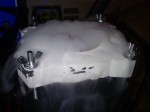«Previous Page 1 2 3 4 5 6 7 8 -View All- Next Page»
Introduction
Why cool to such an extreme level? A simple answer would be to achieve a higher processor speed via overclocking. When the aforementioned process is achieved, even though the frequency may be higher, the efficiency goes down and this wasted efficiency is called heat! Overclocking enthusiasts employ a myriad of differing cooling methods, but what happens when the processor frequency is so high that even water is no longer sufficient? This is where sub-zero cooling comes into its own. This guide will try to employ a simple, non pretentious and a step by step process in order to prepare your precious motherboard for cooling with dry ice!
What is dry ice?
Simply put Dry Ice is frozen Carbon Dioxide at temperatures of -79c It is made by using liquid carbon dioxide and jetted out via a nozzle at an extremely fast speed, collected and compacted into blocks. You can obtain Dry ice in sheets, blocks or pellets. However your best option is in pellet form (around 3mm size) as you need a medium to suspend the dry ice in and the smaller the dry ice pellets are the better; in order for the medium to cover as much surface area as possible.
Here are the Pros and Cons of both types.
Dry Ice blocks (cubes)
Pros:
- Cubes sublime at a slower rate than pellet form.
Cons:
- Because if the size and its suspension in the medium, lower temperatures can be achieved with pellet rather than block form.
Pellets
Pros:
- The medium covers more surface area of the dry ice allowing more efficient cooling
Cons:
- Does not last as long as block form
What is the medium that has been mentioned a few times already?
Dry ice cannot be used by itself; it must be suspended in a liquid form (the medium) in order for the dry ice to have as much surface area covered as possible.
What liquid can I use?
Liquids used are alcohol based and there are many, however overclockers mostly employ the following fluids
- Ethanol (like vodka) can be used but this freezes at -25
- Isopropyl thickens at -50 (looks like Syrupa the this temperature) but freezes at -89
- Acetone (Nail Polish remover) Freezes at -93
- Propanol freezes at -130
The first three substances are easily obtainable however propanol is not. Acetone is more efficient but stinks to high heaven when you first start. So the best all round option, would be Isopropyl.
You can order this from any Boots store costing £7.77 for half a litre £10.99 for 2 litres. DO NOT be tempted to purchase larger amounts as even half a litre will last you many months.
Dry Ice Health and safety information
Storage of dry ice and the use of must always be in a well ventilated area. Dry ice, is potentialy more dangerous than even Liquid Nitrogen as if a small amount of this is spilled over your hands for example; the skin temperature will simply boil the Nitrogen away into a gas. However Dry ice will not, if handled without heavy gloves then a nasty burn WILL occur!
Never seal dry ice in an air-tight container otherwise pressure will occur due to the released gasses. A normal cool box will be sufficient, but with the lid loosely placed on top. Dry ice does not melt, rather it sublimes back into a gas and if the outside temperatures where at around 23c then frozen carbon dioxide will sublime at roughly the rate of 4.4 pounds per twenty four hour period.
Normal air is 78% Nitrogen, 21% Oxygen and only 0.035% Carbon Dioxide. If the concentration of carbon dioxide in the air rises above 0.5%, carbon dioxide can become dangerous. Smaller concentrations can cause quicker breathing but is otherwise not harmful. If Dry Ice has been in a closed auto, van, room, or walk-in, for more than 10 minutes, open doors and allow adequate ventilation before entering. Leave area containing Dry Ice if you start to pant and breath quickly or your fingernails or lips start to turn blue. This is the sign that you have breathed in too much CO2 and not enough oxygen. Dry Ice CO2 is heavier than air and will accumulate in low spaces. Do not enter closed storage areas that have or have had stored Dry Ice before airing out completely.
Burn Treatment
If the worst has come to the worst and you have burned yourself by improper handling of Dry Ice Treat Dry Ice then treat he same as a regular heat burns. See a doctor if the skin blisters or comes off. Otherwise if only red it will heal in time as any other burn. Apply antibiotic ointment to prevent infection and bandage only if the burned skin area needs to be protected. Do not pack NORMAL Ice around the burn as this will cause even more damage!
Do not play around with Dry Ice, no matter the temptation, below is an image of a nasty incident by a young fool storing Dry Ice in an air-tight Coke bottle! This is what happened when he opened the said container.
As mentioned above, never store frozen Carbon Dioxide in an air tight container, as the pressure builds up from the released gas will do the above!
A full Data Sheet on the nature of Carbon Dioxide can be found here.
http://avogadro.chem.iastate.edu/MSDS/carbon_dioxide_solid.htm
This writer cannot stress enough the importance of handling Dry Ice in a responsible manner!
Equipment List
Ok I know about dry ice and its health and safety aspects what additional equipment do I need?
The following are this writer’s recommended but by no means definitive list (as will be explained later)
The most important kit you need would be the cooling apparatus itself. This is a copper tube built to hold the alcohol and the dry ice pellets in order to cool the processor. The best this writer has found can be ordered from www.piotres.com and can be purchased for roughly 130 euros plus delivery for a 1.6 kilogram dry ice pot.
The alcohol suspension medium that was mentioned earlier can be purchased from any ‘Boots’ store. Some prefer acetone others Isopropyl alcohol, none of them are wrong just differing ways to do the same job.
For the FIRST layer of motherboard insulation nail polish of any colour (clear is recommended) Can be purchased almost anywhere
However an alternative to nail polish can be used, albeit at a much higher price, by the name of Dragon FX skin. This substance is used to create masks for the film industry and is entirely water proof and non conductive of an electric current. If you wish to dissemble the equipment after use then the Dragon Skin substance is easy to peel off, leaving no residue behind.
http://www.bentleychemicals.co.uk/
A second layer of insulation must be used, there are many techniques that can be used here and none of them is incorrect, they are just differing solutions the do the same job. However this writer would recommend artists putty eraser (though expensive they can be used over and over again. At least ten of these must be purchased.
Note: some people on using erasers do not use nail polish as first layer; this writer finds this to be a very cavalier attitude and would NOT recommend anyone using this guide to miss out on the first section.
Putty eraser can be purchased from any artists or craft store.
The third layer of insulation can be purchased from any supermarket. These would be paper towels (thicker the better) this reviewer uses the brand ‘plenty’ (One sheet does indeed do plenty) This layer catches any possible condensation drips that may have leaked through the top most insulation layer.
The last layer of motherboard insulation could either be a new covering of putty eraser or sheet of ‘Armaflex’ foam this can be purchased from www.specialtech.co.uk The remaining insulation is exclusively used to wrap around the copper pot itself. Available are tubes of Armaflex foam, these are measured by the insulation thickness and the BORE size. If the copper pot is 60mm in diameter, do NOT purchase a foam tube at the same bore size of the pot, rather use a slightly bore size slightly smaller, so the foam tube ‘stretches’ tight around the copper tube in order to create a seal.
The last piece of insulation would be armaflex insulation tape. This is used to wrap around the mounting posts of the copper pot and to create a nice seal. Again paper towels can be utilised in this area, instead of the tape
As previously mentioned, the armaflex foam and tape can be purchased from www.specialtech.co.uk
A thermal compound, any white gunk will do such as artic cermique, however if you wish to be adventurous an alternative compound can be used which can be utilised is Innovation Cooling’s IC Diamond. However for this substance to work it must be heated before being used in order to ‘fast-cure’ the compound.
This compound can be purchased from www.specialtech.co.uk
A hair dryer, purchased anywhere or borrow your girlfriends.
Last but not least is the bench table to mount everything on. Yes if your budget is tight, cardboard boxes can be used, however if we were to do things correctly then a dedicated review/bench table must be used. The Recommended model would be the Dimastech ‘Hard’ bench table. This is easy to setup, takes minimal room and is easily transportable.
Last and certainly NOT least is the Dry-Ice pellets themselves. The can be obtained in a 10 kilogram bag for about twenty pounds which includes a standard charge for any order. This can be easily obtained from BOC (British Oxygen Company) or simply google Dry-Ice suppliers/manufacturers.
Preparing the Motherboard
Note in this guide the writer is using two differing motherboards in order to further highlight parts. It must be noticed that all motherboards shown were two seperate installations carried about the writer of this article.
Ensure your motherboard is clean and free of dust.
Pick up the bottle of nail polish and carefully paint the area AROUND the CPU socket, (NOT inside the socket itself) not forgetting to coat any MOSFET’s or capacitors around the processor socket area. Once complete leave to dry or alternatively you can use a hairdryer to fast dry the layer of nail varnish. It is recommended to use three layers in order to be safe. Repeat on the underside of the main board.
Handy Tip: You can tell where you have coated the nail varnish as it should leave a highly polished surface. Any dull section is where there is no trace of nail polish.
Handy tip number two: If you choose to use acetone as a suspension medium then this substance can also be used to clean the polish off the main board should the equipment ever needed to be dissembled.
As mentioned earlier in the guide, ‘Dragon Skin FX’ can be used, however the costs of this are much higher than a bottle of nail polish.
Once you are happy that a liberal covering of the system board has been completed then we are ready for the next step.
Assemble your motherboard backing plate hardware (that came with your copper pot). Screw in the M4 mounting bolts, taking care to use the enclosed washers. Once completed place your Armaflex foam sheet through the foam bolts so it rests against the backing plate. If foam sheets are unavailable then putty erasers can be used here. When this is completed simply slide the bolts through the motherboard and push the backing plate firmly against the rear of the motherboard. Whilst doing this place the plastic washers on the motherboard and then tighten the nuts on the other side.
At this stage place a plastic washer on each of the long bolts and slide it down to the surface of the mainboard. Once this has been completed use the securing nut and screw the retaining nuts down.
Handy tip: You may need to push against the backing plate in order to get a tight fitting when using the locking nuts for the assembly
Wow we have covered a lot of ground havent we? Great let us move onto step two of preparing your motherboard for a sub-zero enviroment.
Motherboard Preperation Part Two
Remember the putty eraser we were speaking of earlier? This is where we finally use it. Simply mould the eraser in your hands, until its flat. Some brands of eraser are harder to mould than others; to get around this your mothers rolling pin can be used.
Once flat simply spread the eraser around the system board (the exact places where you placed the nail polish) Make sure the eraser has been pushed right up to the metal processor socket area and that all capacitors are covered. It is advisable to actually cover the whole of the metal socket with eraser, right up to the edge of the processor itself!
Note: that if putty eraser is too expensive then children’s modelling clay is a great alternative to artist’s erasers. However this leaves the motherboard in a mess and would have to be cleaned with Isopropyl alcohol.
HINT: Make sure you push the putty eraser right up to the mounting bolts.
The next layer is simplicity in itself. Cut the paper towel to the shape of the processor socket area and place over the area where there erasers were used.
Hint: The long M4 mounting bolts should punch through the paper towel. Note this is an important layer as it will catch any stray drips of condensation.
IT is at this pount that it would be a good idea to place some vascaline between the CPU and the socket area, or simply insert some spare artist erasers here and mould into shape.
The final layer would be a sheet of Armaflex foam, cut in a similar manner to that of the paper towel.
Hint: if you are short of foam sheets then erasers and or modelling clay can be used.
Congratulations you have completed the first part of the guide, well done!
Preparing and Installing the Dry-Ice Pot!
Once again congratulations on getting this far, let us quickly review what we have covered previously?
- What is dry ice?
- The health and Safety Aspects
- Dry Ice medium suspension
- Equipment
- Motherboard insulation
Preparing the Pot
The most simply way of carrying this out; would be to purchase Armaflex tubing with a size slightly SMALLER bore size then the diameter of the dry ice pot you are working with. The foam allows for a certain amount of stretching around the pot as this is a good thing as you may wish to create an air-tight seal here.
Slide the Armaflex tubing onto the pot- as you would the skin of a sausage, but allow for the foam to be very slightly longer than the length of the tube; as shown below.
Handy Tip: If you can only purchase tubing at the same diameter or larger of the DICE pot then simply cut the tubing to size and wrap tightly around the pot. Secure in place with duct-tape and then place Armaflex insulation tape over the joint.
Remember earlier, that we said the tubing should be cut to a lightly longer length than that of the pot? The reason for this is when the retaining bracket is placed on top then it would a force the extra foam onto the CPU socket area and thus create a nice tight seal.
This is where you place your compound of choice on the CPU. do NOT try to spread out the compound yourself, rather place a 5.5mm blob in the centre of the processor and if need-be fast cure with a hairdryer for about five minutes.
gilgamesh recommends:
Innovation Cooling Perihelion or IC diamond (make sure on the latter that you fast cure the compound by heating it before installing the dry ice pot)
Available at www.specialtech.co.uk
Once completed simply place the Dry-Ice pot in the centre of the four mounting poles and ontop of the CPU IHS
In order to install the top most retaining bracket, simply slide the bracket over the top of the pot-making sure that all the bolts are placed through the correct holes in the top! Once completed place all the washers in their correct places and tighten down the ‘wing’ nuts by the use of the corner to corner method in order to spread out the pressure and the compound to all areas of your processor.
The final finishing touch is to create an extra protective seal and either wrap paper towels or Jay cloths around the post and tape them down in order to create an extra protective layer.
However; if like yours truly you wish to do it the official way then simply use the Armaflex Insulation tape that was discussed earlier in order to achieve the same effect.
WOW congratulations, you have just taken your first steps into a brand new world. You have prepared and insulated your motherboard and installed the dry ice pot itself.
The final part of this guide (honestly) is how to get started in the COOLING of your new setup!
How to Cool your computer down and get those nice sub-zero temperatures.
The secret to cooling your computer down is to slowly lower the temperature. Lower it too fast and you could end up with a cold-boot lock or a motherboard crash.
To help minimise the above, let us use the following steps:
- Place a small funnel into the opening of your copper pot and pour either Acetone or Isopypol alcohol into the funnel and never directly into the copper pot (safe working practices here) and fill the pot to about 1/10th of the way up (DO NOT OVERFILL THE POT) Remember to remove the funnel
- On the initial run-simply place two pellets inside the pot and let them ‘fizzle’ away. Please reffer to the guides safety instructions; that is use an old coffee or styrofoam cup in order to scoup out the dry ice pellets.
- Power on the computer and enter into the BIOS. Here select hardware monitoring (or whatever it says in your particular BIOS) and take a note of the CPU temperature.
- Slowly add more pellets to the pot but once again do not overfill, otherwise the medium will bubble over onto your precious motherboard. You should see your CPU temperatures start to drop.
-
Note it is best to use a K=probe and digital thermometer, however if this is not possible then use the Bios temperature sensor. Though this sensor is not accurate (as we all know) it should give a rough temperature guide. Once you are down to around minus 40 or below then feel free to allow your computer to boot into windows.
The following are a series of shots showing the amount of fog resulting of the dry Ice subliming in the pot.
Final Tip: As one can clearly see, motherboard sensor as not capable of going down to -79c or so that Dry Ice can obtain.
Thats it folks, happy benching
Author gilgamesh






















































